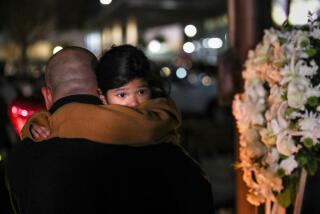Kadafi death: How to explain it to the kids

- Share via
The photo taken by a Libyan resistance fighter of what is purportedly a dead Moammar Kadafi is horrific: a bloodied face frozen in a grotesque death mask. And for several hours on Thursday, it aired steadily on television broadcasts as news organizations scrambled to confirm early reports of Kadafi’s death. To children young and old who are likely to have seen the image —or to find it while surfing the Web in the coming days, what’s a parent to say?
The answer, say experts, depends on the child’s age, of course, and his or her level of anxiety about the graphic and extremely bloody image. But especially for younger children, the message should focus on reassurance: This can’t happen to you or to our family.
But validating a child’s concerns is an important first step, says child psychiatrist Patricia Carrington. An anxious child who has seen the image and asks about it needs to hear her parent acknowledge, “that’s a really scary image.” For older kids, that can be the beginning of a discussion about war and justice and the morality of killing. But with younger kids, says Carrington, keep it simple.
The key, says Maryland child psychologist Mary Alvord, is to “keep it situation-specific and to remind them they are safe.” That may mean noting the uniquely evil behavior of the Libyan dictator, the unique circumstances of a pitched battle for control of the country he ruled, and the enormous distance between that situation and your child’s world.
As you speak, keep the egocentrism of young children foremost in mind, says L.A. child psychologist Kerby T. Alvy.
“Everything gets referred back to themselves,” says Alvy, who is executive director and founder of the Center for Improvement of Child Caring, and an expert on raising resilient kids.
“If your children are seeing this, you really do have to comment on it,” says Alvy, who has launched parenting programs titled “Effective Black Parenting” and “Los Ninos Bien Educados” in Los Angeles. While acknowledging that Kadafi was evil, Alvy cautions against sending young children the message that “he was a bad person and was killed because he was bad.”
Because, says Alvy, if you’ve already made parenting mistake No. 1—telling your child at some point that he “was bad” instead of pointing out his “bad behavior”—then you will compound your error by planting in your child’s mind the notion that since he “is bad,” he too could be killed.
Shutting down the flow of news coverage, adds Carrington, is probably the best policy for young children, who can be easily overwhelmed by images for which they have no context. But if exposure to such images is possible, she suggests, it might be best for parents to go to the Internet and preview those a child might see. Then they can look at some of the tamer pictures together and a parent can offer a bit of age-appropriate background.
Finally, parents should be vigilant for a child’s distress signals in the wake of major world events. Waking at night, anxious partings or sudden tears might all suggest that world events have intruded into a child’s world. Familiar routines as well as reassurance are the best antidote, says Carrington.
More to Read
Sign up for Essential California
The most important California stories and recommendations in your inbox every morning.
You may occasionally receive promotional content from the Los Angeles Times.











